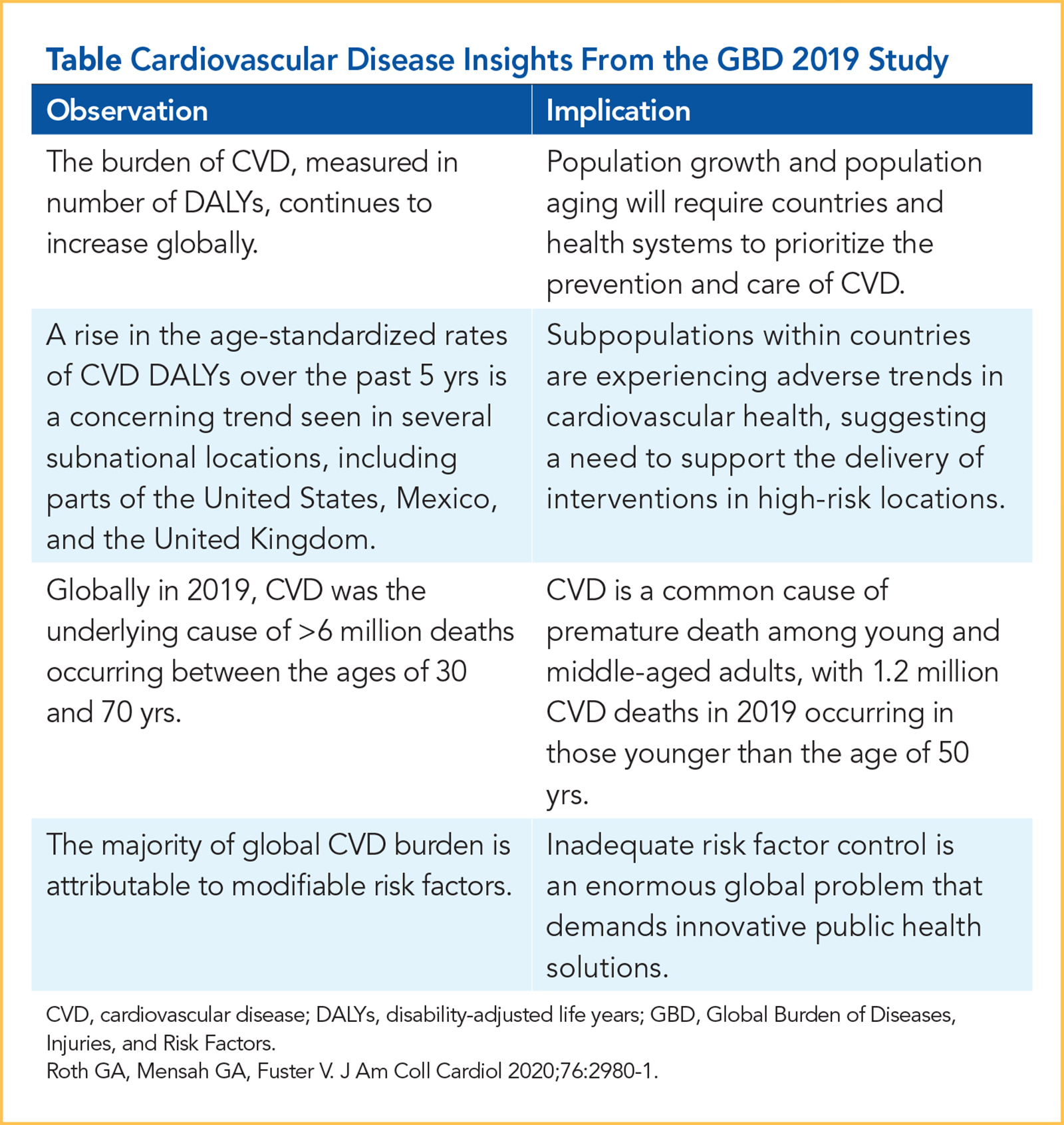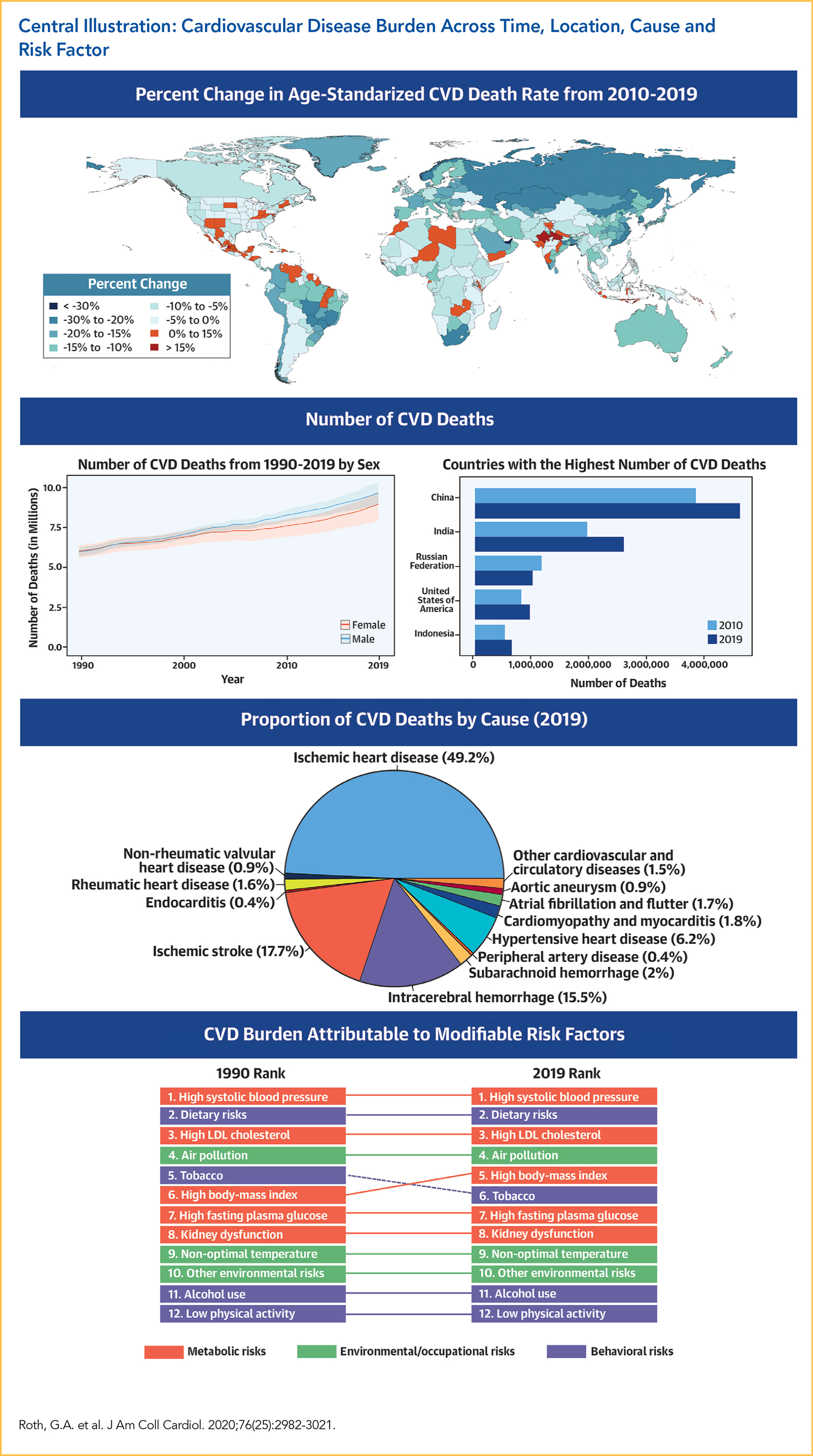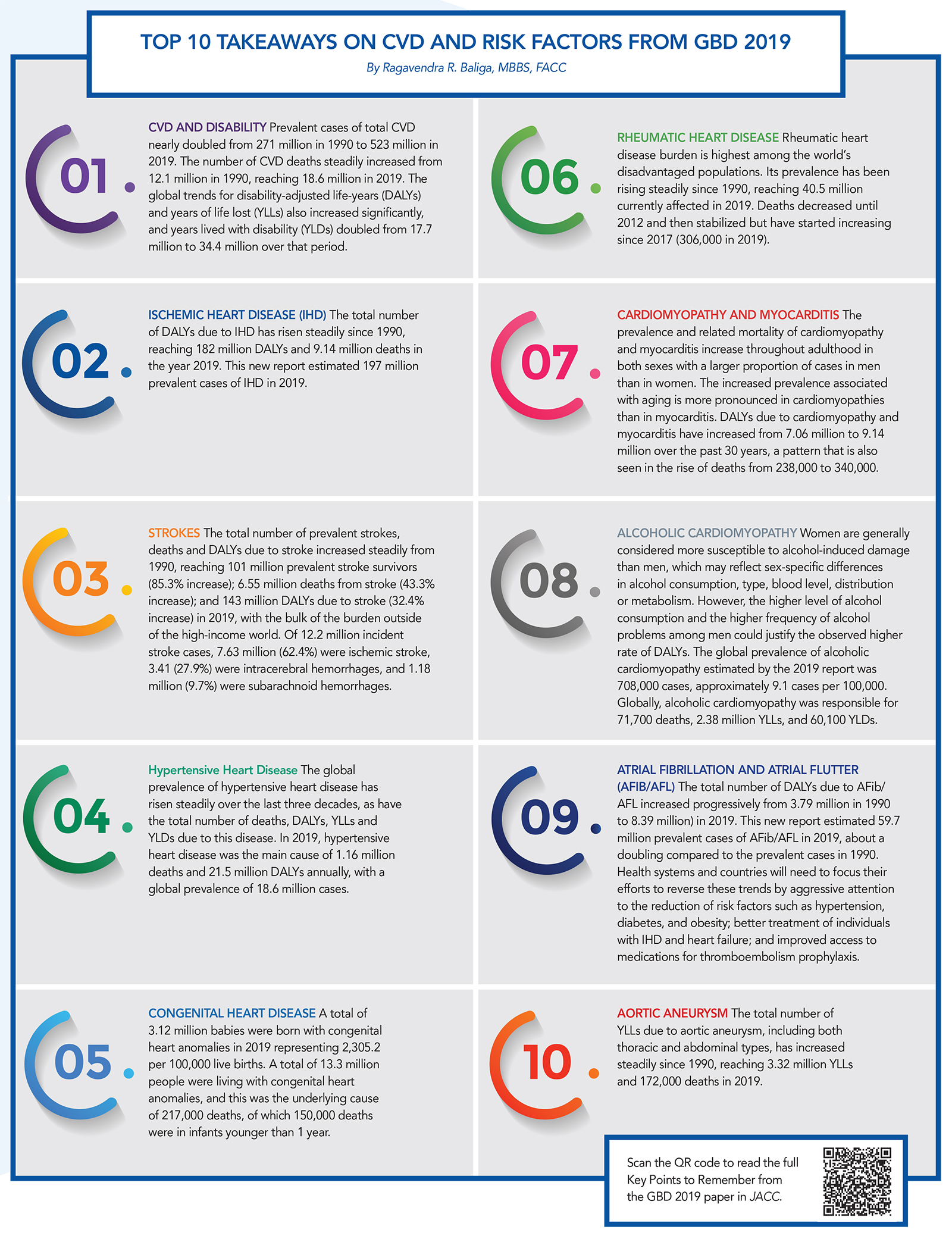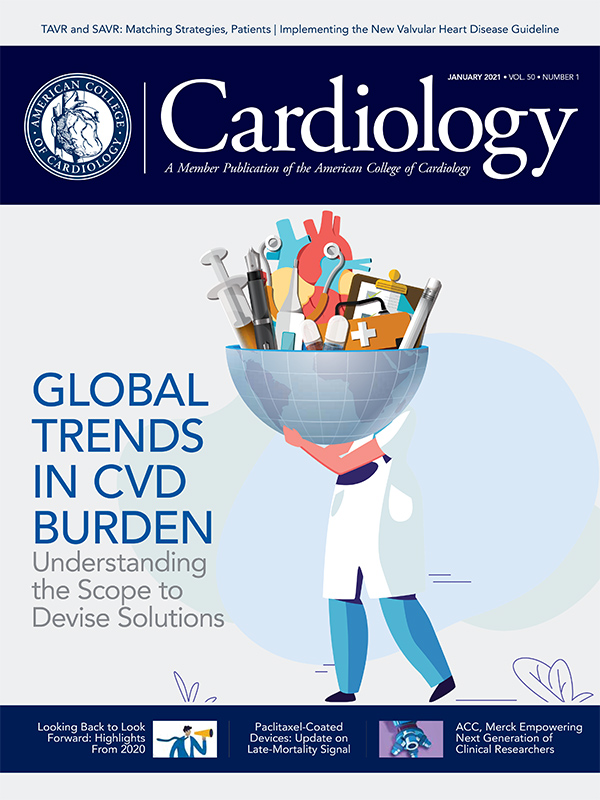Cover Story | Global Trends in CVD Burden: Understanding the Scope to Devise Solutions

The number of people dying from cardiovascular disease (CVD) is steadily rising, encompassing one-third of all deaths globally in 2019, according to a landmark paper published last month in the Journal of the American College of Cardiology (JACC).
The paper, which uses data from The Global Burden of Diseases, Injuries, and Risk Factors Study 2019 (GBD 2019), reviews the total magnitude of CVD burden and trends over 30 years around the world and highlights 13 underlying causes of cardiovascular death and nine related risk factors.
It also underscores the urgent need for countries to establish cost-effective public health programs aimed at reducing cardiovascular risk through modifiable behaviors.
This issue of Cardiology offers a closer look at the key findings from the paper and the opportunities for cardiovascular professionals around the world to use the data and knowledge to optimize patient care and outcomes and truly transform global health. Click here to view the Number Check information graphic feature for more insights from the GBD 2019.
Global Health: What to Watch
In addition to highlighting global trends in CVD, the Global Burden of Disease paper offers insights into potential actions as well as opportunities going forward to turn the tide on CVD mortality. On the watch list:
- Population growth and aging are likely to increase the total prevalent cases of CVD worldwide, according to the study. In particular, countries in Northern Africa, Latin America and all of Asia are expected to be hardest hit. "Effective and affordable clinical strategies remain overlooked by health systems as targets for investments, including methods for noninvasive screening, use of combination pharmacotherapy medications to lower blood pressure and unhealthy cholesterol levels, investment in ambulance services and emergency care including for cardiac arrest, interventional structural and cardiac surgical services including for congenital and rheumatic heart disease, and wider access to rehabilitation services," the authors write.
- Polypills continue to be viewed as a possible solution to help control elevated blood pressure and related conditions, particularly in lower-income countries. Most recently, findings from the TIPS-3 study presented at AHA 2020 found the polypill reduced CVD by approximately 20% compared with placebo in people considered at intermediate risk for heart disease. Patients taking both a polypill plus aspirin saw even greater reductions. According to Salim Yusuf, MD, BS, DPhil, FACC, one of the authors of the TIPS-3 study, use of a polypill plus aspirin could prevent 3-5 million cardiovascular deaths globally and "future polypills, with newer statins, may reduce LDL cholesterol and blood pressure to a greater extent and could reduce cardiovascular disease risk greater than 50%." Click here to read more on the study.
- The prevalence of Rheumatic Heart Disease has been steadily increasing over the last 30 years, reaching 40.5 million in 2019, according to the paper. The authors note that an effective group A streptococcal vaccine could greatly decrease the burden of this disease, especially in low- to middle-income countries. In the meantime, the new ACC/AHA Guideline for Valvular Heart Disease includes recommendations for treating patients with rheumatic fever or evidence of rheumatic heart disease. Click here to read more about the recommendations.
- Peripheral artery disease (PAD) remains highly prevalent, increasing two-fold between 1990 and 2019. The paper notes that "the burden of PAD is increasing not only in developed [high-income countries] HICs but also in [low- and middle-income countries] LMICs, where concomitant risk factors such as diabetes and obesity are increasing." The authors call for greater regulation and further studies to help prevent and treat this disease.
Global CVD Health and COVID-19
Amid the current COVID-19 pandemic, there exists high rates of excess mortality. According to the paper in JACC, much of this additional disease burden may be related to CVD, because of the effects of both viral infection and changes in the delivery of health care and health-seeking behaviors due to pandemic mitigation efforts.
In an Executive Summary accompanying the landmark paper, Gregory A. Roth, MD, MPH, FACC; George A. Mensah, MD, FACC; and Valentin Fuster, MD, PhD, MACC, note that the COVID-19 pandemic and related "large economic setbacks will require renewed commitments to meet Sustainable Development Goal 3, which seeks a 30% reduction in premature mortality due to noncommunicable disease by 2030."
They note that "early studies suggest that direct and indirect excess cardiovascular mortality due to the coronavirus disease 2019 pandemic may be large, further stretching already limited investments in global cardiovascular health" and stress the importance of additional research, as well as continued global action.
"In the face of a global viral pandemic, we still must emphasize global commitments to reduce the suffering and premature death caused by CVD, which limits healthy and sustainable development for every country in the world," said Fuster.
About the Global Burden of Diseases, Injuries, and Risk Factors Study
A multinational collaborative research effort, the Global Burden of Diseases, Injuries, and Risk Factors Study estimates the burden of disease for every country worldwide. Updated annually, the study provides for consistent comparisons from 1990 to 2019, by age and sex and across locations. New diseases, new data sources and updated methods are included in the annual updates.
Standard epidemiological measures, such as incidence, prevalence and death rates, along with summary measures of health, such as disability-adjusted life-years (DALYs), are provided by the study. DALYs, the years of life lost prematurely and years lived with disability, are estimated using life tables, estimates of prevalence and disability weights.
Air Pollution: A Modifiable Risk Factor
Data from the GBD 2019 reinforce the impact of air pollution on health outcomes, including CVD. Learn more about this impact in a recent review article in the Journal of the American College of Cardiology. Click here to start reading about this CV risk factor.
What Cardiologists Can Bring to Global Health
How can cardiovascular professionals contribute to promoting advances in cardiovascular care at an individual and population level around the world? Michel Ibrahim, MD, a Fellow in Training at Boston University Medical Center, shares his insights on pursuing an advanced heart failure and transplant fellowship while also contributing to advancing cardiovascular care in his home country of Haiti. Click here to read more and be inspired.
Clinical Topics: Arrhythmias and Clinical EP, Cardiac Surgery, Congenital Heart Disease and Pediatric Cardiology, COVID-19 Hub, Dyslipidemia, Heart Failure and Cardiomyopathies, Prevention, Valvular Heart Disease, Atherosclerotic Disease (CAD/PAD), Implantable Devices, SCD/Ventricular Arrhythmias, Atrial Fibrillation/Supraventricular Arrhythmias, Aortic Surgery, Cardiac Surgery and Arrhythmias, Cardiac Surgery and CHD and Pediatrics, Cardiac Surgery and Heart Failure, Cardiac Surgery and VHD, Congenital Heart Disease, CHD and Pediatrics and Arrhythmias, CHD and Pediatrics and Prevention, CHD and Pediatrics and Quality Improvement, Lipid Metabolism, Nonstatins, Novel Agents, Statins, Acute Heart Failure, Hypertension
Keywords: ACC Publications, Cardiology Magazine, Academic Medical Centers, Aging, Alcohol Drinking, Ambulances, Aortic Aneurysm, Aspirin, Atrial Fibrillation, Atrial Flutter, Brain Ischemia, Blood Pressure, Cardiology, Cardiomyopathy, Alcoholic, Cardiovascular Diseases, Cholesterol, LDL, Cerebral Hemorrhage, Coronavirus, severe acute respiratory syndrome coronavirus 2, COVID-19, Cost of Illness, Delivery of Health Care, Developed Countries, Developing Countries, Diabetes Mellitus, Fellowships and Scholarships, Goals, Global Health, Heart Arrest, Health Services Accessibility, Heart Defects, Congenital, Heart Failure, Heart Valve Diseases, Hydroxymethylglutaryl-CoA Reductase Inhibitors, Incidence, Hypertension, Information Storage and Retrieval, Life Tables, Mortality, Premature, Myocardial Ischemia, Latin America, Live Birth, Myocarditis, Obesity, Peripheral Arterial Disease, Population Growth, Prevalence, Pandemics, Quality-Adjusted Life Years, Reference Standards, Rheumatic Heart Disease, Stroke, Risk Factors, Subarachnoid Hemorrhage, Conservation of Natural Resources, Survivors, Vaccines, Thromboembolism, Vulnerable Populations
< Back to Listings




